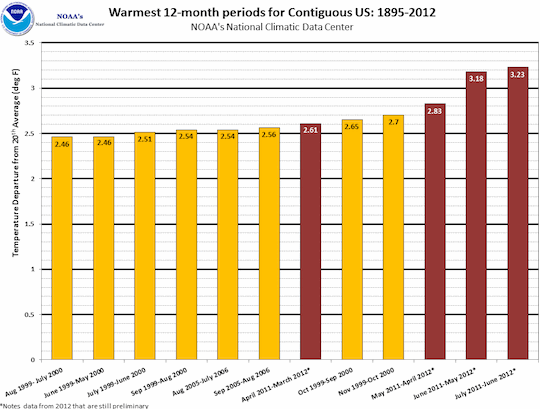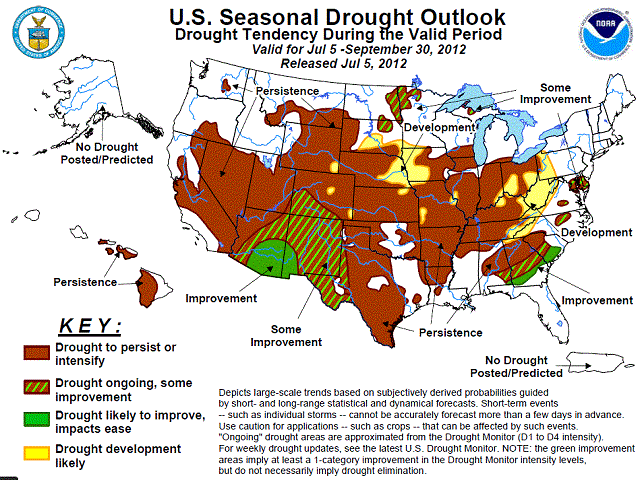US Sees Hottest 12 Months & Hottest Half Year On Record
 The National Oceanic and Atmospheric Administration (NOAA) has released its chart-filled “State of the Climate Global Analysis” for June 2012:
The National Oceanic and Atmospheric Administration (NOAA) has released its chart-filled “State of the Climate Global Analysis” for June 2012:The big stories are the heat and drought:
The average temperature for the contiguous U.S. during June was 71.2°F, which is 2.0°F above the 20th century average. Scorching temperatures during the second half of the month led to at least 170 all-time high temperature records broken or tied. The June temperatures contributed to a record-warm first half of the year and the warmest 12-month period the nation has experienced since recordkeeping began in 1895.
According to the U.S. Drought Monitor, as of July 3, 56.0 percent of the contiguous U.S. experienced drought conditions, marking the largest percentage of the nation experiencing drought conditions in the 12-year record of the U.S. Drought Monitor.
How off-the-charts has the last year been? NOAA has done the math:
During the June 2011-June 2012 period, each of the 13 consecutive months ranked among the warmest third of their historical distribution for the first time in the 1895-present record. The odds of this occurring randomly is 1 in 1,594,323.
As meteorologist Dr. Jeff Masters puts it, “Thus, we should only see one more 13-month period so warm between now and 124,652 AD–assuming the climate is staying the same as it did during the past 118 years. These are ridiculously long odds, and it is highly unlikely that the extremity of the heat during the past 13 months could have occurred without a warming climate.”
Like a baseball player on steroids, our atmosphere has been “juiced” with human emissions of greenhouse gases, which means we are going to be breaking heat records at an “unnatural” pace for a long, long time. Climatologist Richard Alley offers a different analogy in a column today:
Humans have made some extreme weather events more likely, and they are happening.
Just as a back-street gambler might beat someone in an honest game but has a better chance with loaded dice, Nature might have caused this summer’s weather but we gave it a boost. More importantly, under business as usual, today’s children may one day think of this summer as cool.
How extreme has the weather been in 2012?
The U.S. Climate Extremes Index (USCEI), an index that tracks the highest and lowest 10 percent of extremes in temperature, precipitation, drought and tropical cyclones across the contiguous U.S., was a record-large 44 percent during the January-June period, over twice the average value. Extremes in warm daytime temperatures (83 percent) and warm nighttime temperatures (70 percent) covered large areas of the nation, contributing to the record high value.
Here’s the chart:
Unfortunately, NOAA offers little near-term hope for alleviating the drought. Here’s their forecast through the end of September:
This does not bode well for US crops.
And since it tends to be hotter in a widespread drought, there’s every reason to believe the above average warmth will continue. Mother Nature is just getting warmed up!


You can return to the main Market News page, or press the Back button on your browser.

